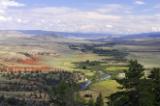Understanding Conservation Priorities: Laramie Foothills
Colorado: Mountains to Plains
One of the holy grails of conservation is to find among the ever-sprawling human society, the still-sprawling wilderness. Massive spreads of unfragmented nature are conservation’s ultimate safety nets, harboring the potential to catch the fullest complement of conservation values within their boundaries. They carry the biggest potential for the widest variety of wildlife, the grandest displays of geology, the most awe-inspiring vistas to lift the human spirit.
They are also, of course, increasingly hard to come by, and typically threatened with development and the ubiquitous death by a thousand cuts. When such a rare and unspoiled spread is discovered, it takes a cohesive force—one that is both powerful and nimble—to protect it.
One such remarkable conservation effort is underway in northern Colorado, in a frontier land where the Great Plains meet the Rocky Mountains. It is a grand landscape called the Laramie Foothills, which recently remains whole through the rapid actions of a potent force of citizens and their governments, unified by a common vision.
Where the antelope play
The Laramie Foothills is naturally rich and varied and serves as critical habitats for wildlife large and small. The wide open spaces serve wide-ranging wildlife, as calving areas for pronghorn antelope and winter food and shelter for deer and elk. For the elk, this is also one of the few places in Colorado where their herds still venture onto their native plains.
The Laramie Foothills retains swaths of prairie grasslands so often plowed elsewhere; the hills grade into fragrant juniper woodlands and then into shady forests of ponderosa pine. Birdlife gravitates to the’streamside oases, and fish to the perennial waters. In these rugged canyon lands, rare plants take root and raptors build nests on the rocky cliffs.
The Laramie Foothills also preserves cultural values, to the roots of America’s human history. They preserve the archaeological remains of the Folsom people, who hunted giant bison here with their exquisite spearpoints more than 11 thousand years ago. There are many artifacts as well of the peoples who followed them: the Apache, Arapaho, Cheyenne, Comanche, Crow, Kiowa, Lakota, Pawnee, Shoshone, and Ute. And there remains the living presence of the cattle rancher, which for the last 150 years has dominated the cultural landscape.
When suburbia comes knocking
Five years ago, when those ranchers of the Laramie Foothills—whose immense family holdings had for generations preserved their venerable culture along with its unbroken vistas—began to feel pressure to subdivide their ranches to a booming suburbia of Ft. Collins, conservationists were as alarmed by the projected losses as they were poised to prevent them.
The Nature Conservancy had twenty years earlier recognized the ecological value of the unbroken landscape, and had quietly put down roots with a preserve called Phantom Canyon. The citizens of Ft. Collins and the governing county of Larimer, for their part had with foresight enacted taxes earmarked for acquiring open space. The conservation-minded of northern Colorado knew the stakes. All were informed, and all were watching when the building boom of the 1990’s started parceling the open spaces into 35-acre prairie palaces. Fortunately, the conservationists had not only knowledge, but money, so when big chunks of the Laramie Foothills rather suddenly went up for sale, they were positioned to buy.
Over the following five years, Coloradoans bought and set aside 35 thousand acres of the Laramie Foothills as a unified model of preservation, with another 20 thousand acres in their sights. Their big ambitions have been well rewarded.
Today there is still something other than second homes and starter castles dotting the Laramie Foothills’ horizons. With the land's preservation comes a more benign cultural infusion, of visiting hikers and bikers and horseback riders, of wildlife watchers and photographers.
As part of the conservation plan for the Laramie Foothills, these pursuits of leisure and human renewal are invited to meld with that of the livestock rancher and his livelihood, guided by selected trails that minimize conflicts while lightening the human footprint. All are fed in their own way by the wealth of the land—a wealth made possible by its wholeness, its wholeness made possible by a strategic conservation plan, founded on a collective sense of value and vision.





